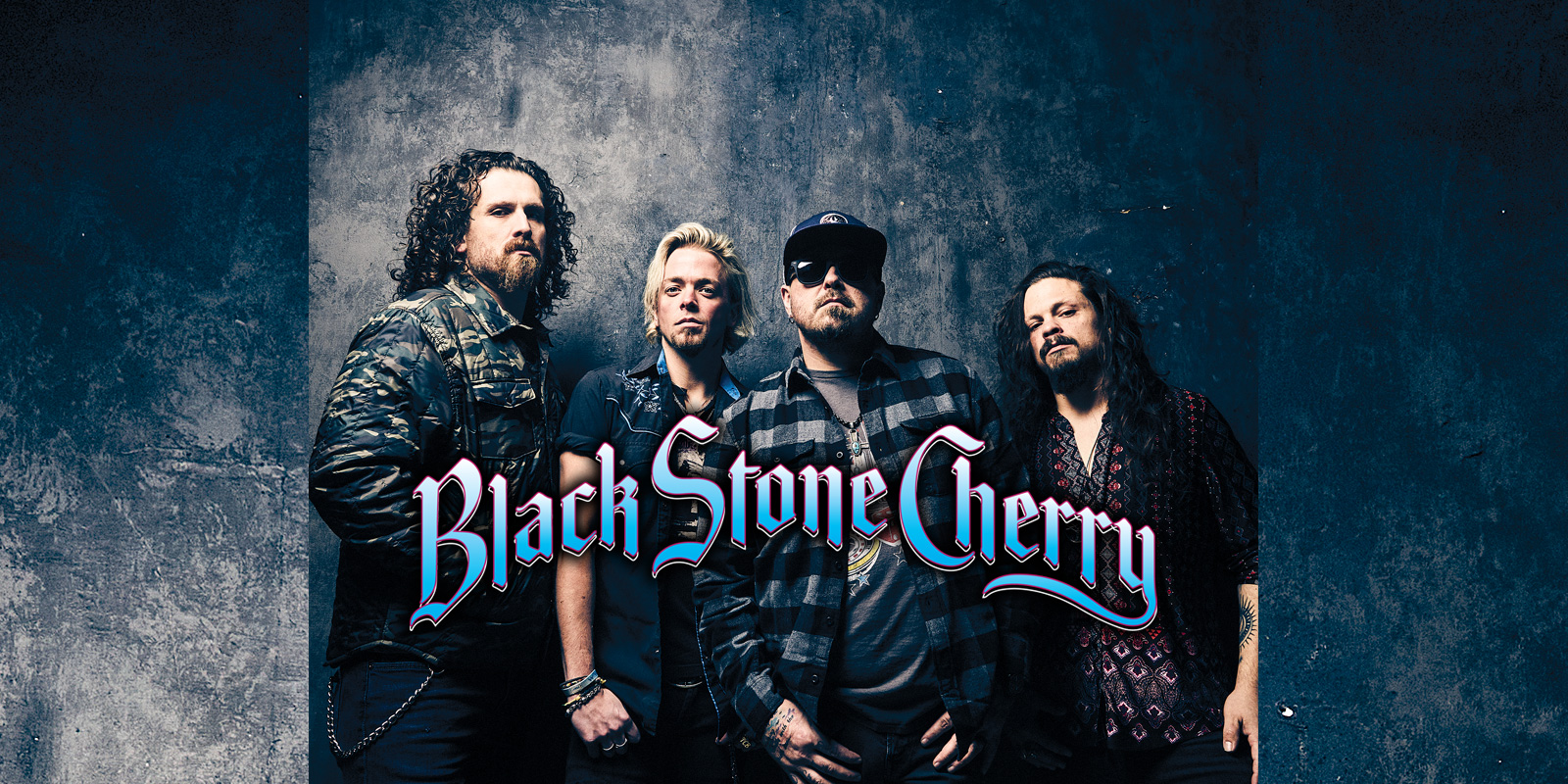Interview by Paul Vnuk Jr.
Black Stone Cherry is a Southern hard-rock metal band formed in Edmonton, Kentucky in 2001. The band is comprised of Chris Robertson (lead vocals and lead guitar), Ben Wells (rhythm guitar), Steve Jewell (bass) and John Fred Young (drums). The band has released eight full-length studio albums. The latest, released in late 2023, is Screamin’ at the Sky, a largely DIY affair recorded and produced by the band alongside the band’s in-house engineer Jordan Westfall. The drums were tracked in an old 1920s theater, with further tracking at drummer John Fred’s home. Perfectly timed for our drum-themed issue John Fred and Jordan take us behind the theater curtains for the details.
On Mastering
 So tell me about recording the new album. I heard you did the drums in an old theater?
So tell me about recording the new album. I heard you did the drums in an old theater?
John Fred: When we started talking about making a new record and where to record it, I suggested, “Why don’t we record drums in my kitchen?” In my mind, I’m thinking “big open spaces,” You know, John Bonham sounds—I’ll turn the kitchen into a castle. But it could also be a problem with the room not being treated, and the drums might get a little lost. I think, more than anything, the band was probably worried that I was going to do a drum take and then go try to make eggs or something. [Laughs.]
Then somebody had the idea to record the drums at the old Plaza Theater in Glasgow, Kentucky. Every two years, we’ve been doing a Christmas show there. It’s a 1920s theater, so the architecture is beautiful and it’s just got a vibe, and it sounds incredible.
So last summer, we had a break in touring, and we loaded all this gear into the Plaza. We set the drums up on stage, and Jordan set up all the recording gear in the basement. We hit some drums, and it was just like, “Wow, that’s magic!” So we tracked the drums, then we took a six or seven-month break for touring, and we went back and finished in the wintertime.
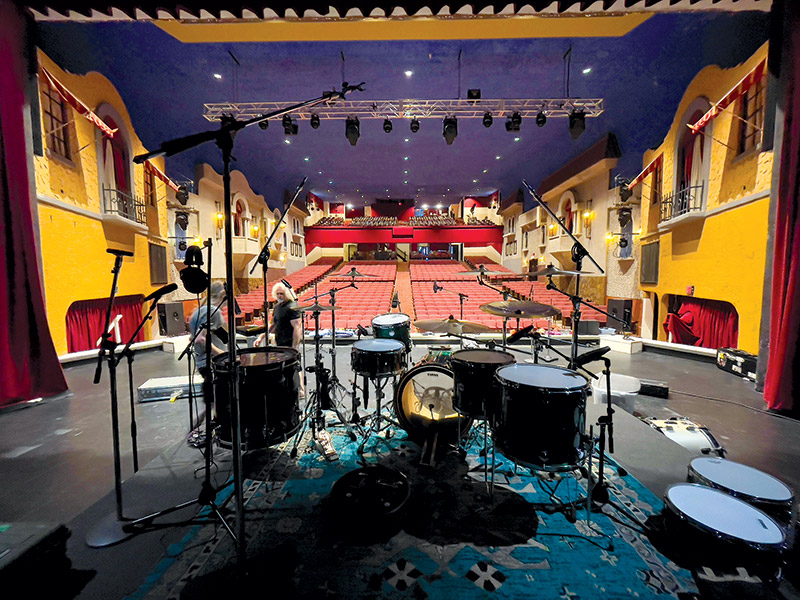
The drummer’s view of the Plaza Theater
Photo by Jordan Westfall
Did you record the whole album there?
Chris, Ben and Steve tracked some stuff there as well, but for most of the rest of it, we came back to my house and just piled their gear into my two back bedrooms. We did the guitars, bass and vocals here. We built a vocal booth out of some PVC pipe and some moving blankets. So it was pretty DIY.
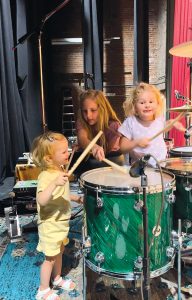
Future drummers!
Photo by Jordan Westfall
That’s wild to take a DIY approach after 20 years of making albums in some professional rooms. When you were tracking drums, were you playing along with demos, or did the other guys play scratch parts with you?
John Fred: I played along to scratch tracks. The way we write—and thank goodness we’ve got phones that record well now—is that one of the guys will come up with a riff, and we might work it up at soundcheck or a lot of our songs are written on the back of the bus. Chris will bring his laptop out, and we pile back there and lay down scratch guitars, bass and a scratch vocal, and I was playing to that.
When we did the record before this one, The Human Condition, Jordan had the idea that recording to the scratch tracks allowed the rest of the band to sit in the room and really focus on the drum tracks and how they fit with the parts.
At first, I was kind of like, “Oh, man, I’ve never really done that,” you know, play the drums last instead of first. We came from the school of get everybody in a room, play and get a couple of really good drum tracks. Then you can go back to add and replace guitars and stuff.
But his idea of me playing to the scratch track as the rest of the band listens really helped me personally because there are five sets of ears listening, and people catch things I wouldn’t.
Does it ever get frustrating with having too many ideas flying around, or maybe just thinking, “Hey, I’m the drummer?”
John Fred: The way we write is sort of like a big collective. I might have a guitar melody in my head, and I’ll hum it or I’ll peck it out on the keyboard, and Chris might have a drum part that’s really cool.
It’s easy to think you’ve got a part for a song that’s like the most epic part ever, but at the same time, you’ve got to be open to trying stuff because somebody else’s idea may suit the song better, or it’s something you would have never thought of. We’ve always worked like that, from vocal melodies to the drum parts to guitars and bass.
I will say that there are times when you’ve got so many people throwing ideas at you all the same time your brain kind of gets overwhelmed, but I’m always, always willing to try it. Of course, we do the same thing when it comes to guitars or vocals, and then Chris is always like, “Here we go, they’re going to eat me alive.” [Laughs.]
Drum tracking on stage
Photo by Jordan Westfall
When you are tracking, do you do full takes or do things in sections or punches?
John Fred: Everything’s a one-take with me—everything from start to finish. No, punch-ins. Just one take…[dramatic pause]. No, dude, I wish. Are you kidding me? My takes look like a chopped-up piece of brisket. [Everyone breaks out laughing.]
Engineer Jordan Westfall below the stage
Photo by Jordan Westfall
You almost had me there! Jordan, what did you bring with you for tracking in your DIY control room?
Jordan: We basically took like four different recording studios’ worth of gear. We set up in the green room, which was underneath the stage, down these old damp stairs (which got all icy in the winter). We had these big old racks of gear—Shadow Hills mastering compressors, Lachapell Audio vacuum tube preamps, and all this high-dollar stuff—nervously taking it down these icy stairs, and we set up everything on a pop-up picnic table.
The room is full of big theater mirrors and hard services. So we had to deal with that, and we used Sonarworks room correction software to get that more in check.
Then we ran stage snakes from the green room upstairs to the theater area, and John Fred set the drums up on a 12′ x 8′
drum riser in the middle of the stage. We thought we might move the set around to find the best-sounding spot, but it sounded great there, and we left it.

Jordan Westfall’s mixing room
Photo by Jordan Westfall
I’m assuming you were tracking to Pro Tools, and how many channels?
Jordan: Pro Tools, absolutely. I had around 22 to 24 channels altogether. Everything was close miked and about 10 of those were room mics.
What interfaces did you use?
Jordan: It was all Universal Audio—an Apollo x16 and an x8.
Nice, that’s what I use in my studio.
Jordan: I love it. I’m an Apollo fan-person.
What was your drum setup for this album?
John Fred: We actually used my all-maple DW (Drum Workshop) touring kit on this record. It’s basically a 12″, 14″ and 16″ tom set up with a 22″ kick, and I’ve got a 20″ gong-drum for the end of phrases if we need a big, deep impact.
I also used a bunch of different snares—some DW and some VK drums from a guy in England called Alan Van Kleef who makes some killer steel and iron snare drums that weigh about 40 pounds. I used some Keplinger iron snares, an Oriollo bell brass snare made in Slovenia, a Sakae bell brass snare and I also used one of Chris’ Pork Pie snares. That was on the ballad “R.O.A.R.” (raindrops on a roaster). It’s a monster ballad, and we needed that big wood, open, thick, deep snare sound.
Jordan, did I have a Black Beauty?
Jordan: That one might’ve come in for the second session at the theater. The second time, we had a couple of other snares that we didn’t have the first time.
John Fred: Yeah, we used a bunch of different stuff. It was so much fun—you’re always experimenting, especially when you are tracking in a new space.
Are you a cymbal-happy guy?
John Fred: Chris would say I’m a cymbal-happy guy—he probably thinks I’ve got 27 cymbals. I think I have a pretty simple setup. Most of them are Zildjian K Custom Dark cymbals. I’ve got a few crash cymbals, my ride, a 20″ China and then I use 15″ master sound hi-hats.
Jordan: I remember we were swapping rides for songs, too.
Jordan, how did you mic these up?
Jordan: We had vintage hand-wired Neumann U87 mics in a spaced pair for overheads. Then I added an X/Y set of overheads using Steven Slate ML2 modeling pencil mics—probably 10’ above the drum set. The close mics were Sennheiser 421 dynamic mics on the toms.
The snare was a Telefunken M80 on top and a Sennheiser 441 underneath. Neumann KM 184 pencil condensers for the hi-hat and the ride, and then I think the kick drum was an old Shure BETA 91 for the kick-in mic and a Warm Audio FET 47 Jr. for the kick-out.
For me, the FET 47 Jr. is one of the best bang-for-buck microphones on the planet right now. It’s got vibe; it’s not boring; and it’s under $400 bucks and it sounds great on everything.
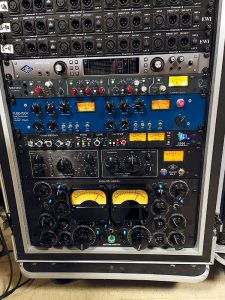


What was your front end?
Jordan: A lot of the preamps were the Warm Audio WA-73 and the Black Lion Audio B12a (the 312 clones), and for some of the room mics, we used SSL VHD+ preamps so we could really crank up the harmonics. Then, for snare, we used a Rupert Neve Designs Shelford.
What did you use for the room mics that you put around the theater?
Jordan: The closer room mics were Warm Audio WA-87 condensers, and then I used one of their WA-67 tube mics way in the back of the theater as a big mono crush mic.
Then, we also placed a Steven Slate ML-1 large diaphragm mic underneath the drum riser.
Under the riser?
Jordan: Yes, it was great for getting a cool low-end resonant boom every time he’d play the toms. Then I’ve got a thing I do when recording drums where I’ve got two bricks that have gone with me on every single session I’ve done in the last 15 years. They’re my mobile drum room.
I measure off about 10′ to 15′ away from the drums on either side, put the bricks down and mic those with whatever mics are left over—like a small dynamic mic or pencil condensers.
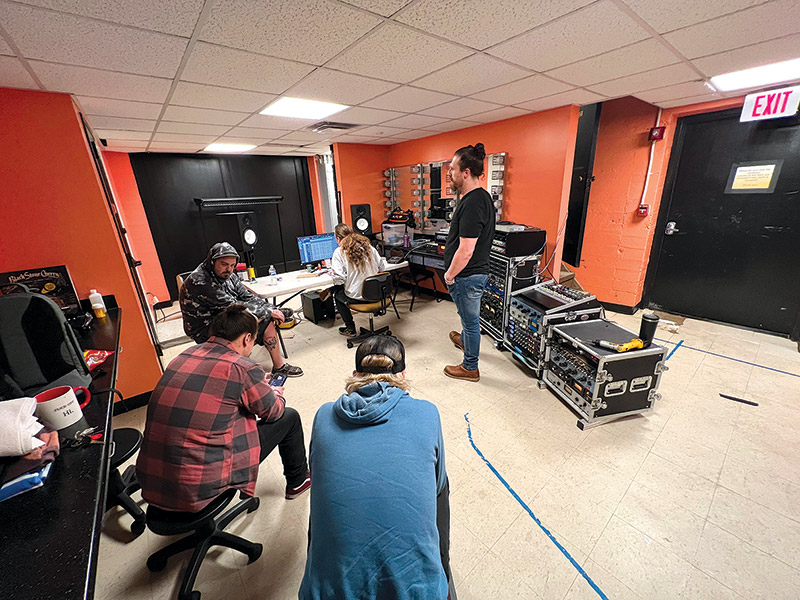
The mobile control room in the basement of the Plaza Theater
Photo by Jordan Westfall
So what happens next? Are you doing a lot of post-drum processing or sample replacement?
Jordan: The drums pretty much are the tones that we got at the Plaza—the super dry kick, the crushed mono room mic and the tom tones and such.
Then, the blend, the width and the ambiance are very track-dependent. Is it a fast track? Does it need a long ambiance? Does it need bigger decays to fill that space? Does it need to tighten up and just be punchy dry close mics and raw?
When you’re mixing, are you mixing primarily in the box?
Jordan: It’s a hybrid workflow. I started off on consoles and the tape machines, and when I switched to full digital, I was like, “I love this; I don’t have to recall anything, and the electric bills are manageable.” And now, I find myself going back out of the box after years of being in it. I think there’s something about that sterile, inky blackness of digital that makes me uncomfortable at the end of the day.
So running some sound through some analog boxes and getting a little bit of that hissing, that hair in there is a big part of audio recording for me.
How did you get interested in making records?
Jordan: My dad, Bill Westfall, was a bass player in the 80s hair metal band Banshee that got signed to Atlantic back in the day and they were produced by Eddie Kramer. I was two or three at the time and Pops had me in the studio and sat me in Eddie’s lap, and he let me push around faders on the console—that was my introduction to the studio.
So I grew up with the musician dad, who was always in and out of the studio making records, and I was always there with him. Eventually, I became a bass player and I wanted to be the next Jaco. One day Pops was like, “Hey, I got this band I’m recording, do you want to help?” I was like, “Yeah,” and that was it. I was like, “I’m recording rock and roll for the rest of my life.”
How did you hook up with these guys?
Jordan: I was touring with another band called Shaman’s Harvest out of Missouri, and they were opening up for the band. Black Stone Cherry set the bar for me—this is how you’re supposed to tour and survive on the road, and how you’re supposed to be towards other people, just like a family. Then, I got a text from their tour manager saying they needed a monitor engineer for Europe. I was like, “I’m there, dude. Let’s go!”
John Fred: So Jordan came out, and he’s doing our in-ear mix, and I remember I looked at Chris I was like, “I can hear! So that’s what these are supposed to sound like.” Then we heard some of the mixes Chris was recording of our shows, and that was it.
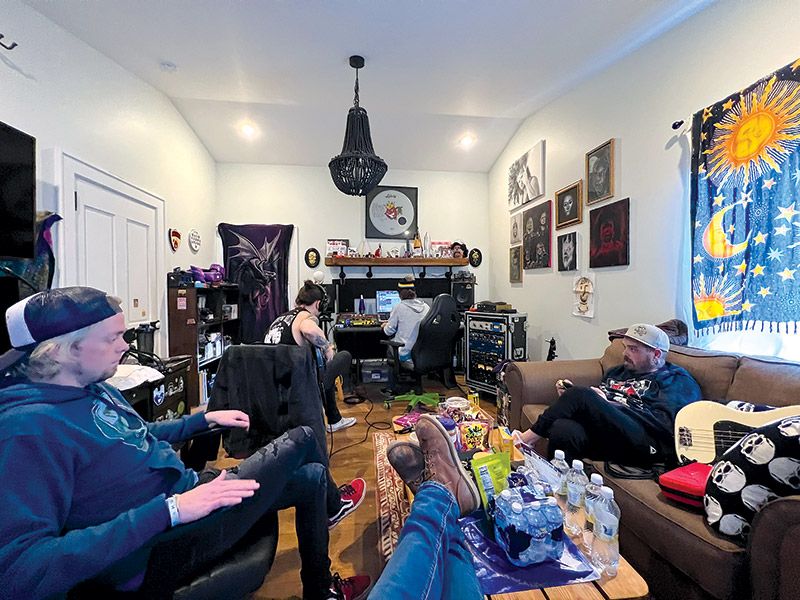
John Fred’s home studio
Photo by Jordan Westfall
So take me from the theater to recording at your house.
John Fred: My dad and uncle play in the Kentucky Headhunters,
that’s how I got into music. We live on a farm down here, and I bought this old bungalow-style house when I was 21, thinking one day, I will have a little home studio here. So that’s what we did, we used my two back bedrooms. It’s funny because Chris and I have known each other since kindergarten. We were in Boy Scouts with each other and grew up together in school. We love each other so much, but we constantly pick at each other as well. Chris was like, “Even though we’re doing it at your house, do you think you’ll still be late to the sessions?”
I have three little girls, and they’re three, five and eight. I’d take them to school, and we’d start about 9 a.m. and every day around 3:30 p.m, Chris would be in there singing in the bedroom, cutting vocals, and I’d be running down the hall because my middle daughter Sage, she’s a firecracker, was heading toward the back bedrooms. I’d be like, “Sage, listen to me. You gotta be really quiet when we’ve got the door closed.” And Chris was in there rocking out and doing his vocals, and then this little head would peek through the door and behind the curtain and in the middle of the take, we’d hear, “Sage, what are you doing?” [Everyone laughs.]
I love this story because it’s something to which I think a lot of us who are recording at home with kids can relate. Before you started adding guitars and vocals, I assume you edited the drum parts?
John Fred: Jordan does all the drum editing, and he’s world-class at that. And I trust him to do that. We also did something pretty cool this time during tracking—we focused on specific parts, like a chorus, until it felt right.
I’d listen to the demos and come up with different drum parts. Then we’d do a few takes all the way through, and then just start focusing on a chorus, getting it to where everybody’s like, “Oh, yeah, that’s the part, that’s the hook.” (The big community effort thing again.) Then we would move to the verses and maybe do intros and outros, maybe the bridge last.
Jordan: When we started, the songs were pretty much already roughed out, and we would strip out the “thumb drumming” from the demos, get levels and do two or three full passes front to back just to get comfortable with the song and grab some of the magic that happens on initial takes—and then all of that gets play-listed.
Then, we’ll start putting it all under the microscope—what’s the perfect groove for the chorus? Is the bass drum locking in with what the bass might want to do? Are we stepping on the vocals here? We’ll go ahead and get like five or six different choruses and make sure that everything’s great—and there’s little tiny variances in every single one of them.
Then, after all of the tracking is down, everybody will sit down around the computer, listen to playlist after playlist after playlist. Is this the right fill for this part? Do we have everything we need?
So you are still making the decisions then and there and not months later?
Jordan: Yes, when we come out, the takes are the takes, and we just comp them together as close as we can before we leave. From there, it’s maybe 5-10% of having to go in and quantize or just kind of shift some stuff around.
And with this particular band, that’s the process for everything. Everybody is equal at every step of the game. Everybody’s sitting there comping drums together. We’re all working on bass together. We’re all working on everybody’s guitar together and vocals.
By the time I leave, all of the decisions are made and I’m ready to mix. The editing is done and I can just focus on the music being the music.
Was the bass direct or through an amp?
Jordan: The bass was direct, but I did split the signal with one channel through the RND Shelford and then touching the opto side of the Shadow Hills Mastering Compressor just for a little bit of color.
Then for the other channel, I have a Darkglass Microtubes X Ultra Pedal that I sent into an amp and cab sim in post.
What about the guitars?
Jordan: Chris used Line 6 Helix for the entire record, but he’s able to dial that thing in and get a great tone. Ben used a Peavey 5150 amp head going through a 412 cab, but instead of miking it I used a load box between the head and cabinet so we were able to play with some cabinet impulses in post.
And what mic did you use for vocals?
Jordan: We shot out a lot of microphones: Shure mics and high dollar Neumann U87 mics, but we had a Slate ML-1 just sitting in the corner. We tried it and it won in a blind shoot-out against everything.
What mic virtual model did you end up with?
Jordan: I ended up on their Sony C 800 model.
Paul: Wow.
Jordan: Even there I was certain the AKG C12
model would probably win it, but it was the C 800.
Where did you mix it?
Jordan: I brought it back to my place to mix.
Do you have any standout plugins or gear that you used?
Jordan: On snare, my go-to reverb is the EMT 240 Plate. And then there’s something about just the classic 1980s hardware reverbs that I can’t get away from, namely the Yamaha SPX90. Currently, I’ve just added an API 2500 bus compressor, which I’ve been absolutely loving, but on the Black Stone Cherry record it was a STAM Audio SSL clone—the 500 series version and then that also went through a Kush Audio Claraphonic parallel EQ.
Are you doing a lot of automating in the mix to get those big theater spaces to pop out when they can, and then dry up the space for other parts?
Jordan: I am also a big fan of the SSL Channel Strip gate. I’ll take that and change the release time, depending on the speed of the song. That gate rolls down to like 300 milliseconds so it’s easy to make things go from a huge, massive sound to a tight, intimate space.
And then, there is a lot of automating the levels of the different mics within the room.
Was there any final input from the band in the mix stage?
Jordan: After I was done, we all got together at a studio in Bowling Green, Kentucky, for one day, again everybody in the room, for a final listen and a chance to catch anything before it went to mastering.
I love the camaraderie that comes through in talking with you and the family vibe you share, along with the DIY nature of the album and your very accessible gear choices.
John Fred: I think it’s easy to get wrapped up into thinking that you’ve got to have the most expensive gear, and I know many musicians are very brand loyal, but in the end, it’s about loving the music.
We’re fortunate to be four dudes from an itty-bitty town in Kentucky and we get to go out and tour and make records. We are blessed to have put together such a great team to do it with.
I appreciate this, thank you.
John Fred: Thanks so much for having us, man. We really appreciate you.
Jordan: Thank you.
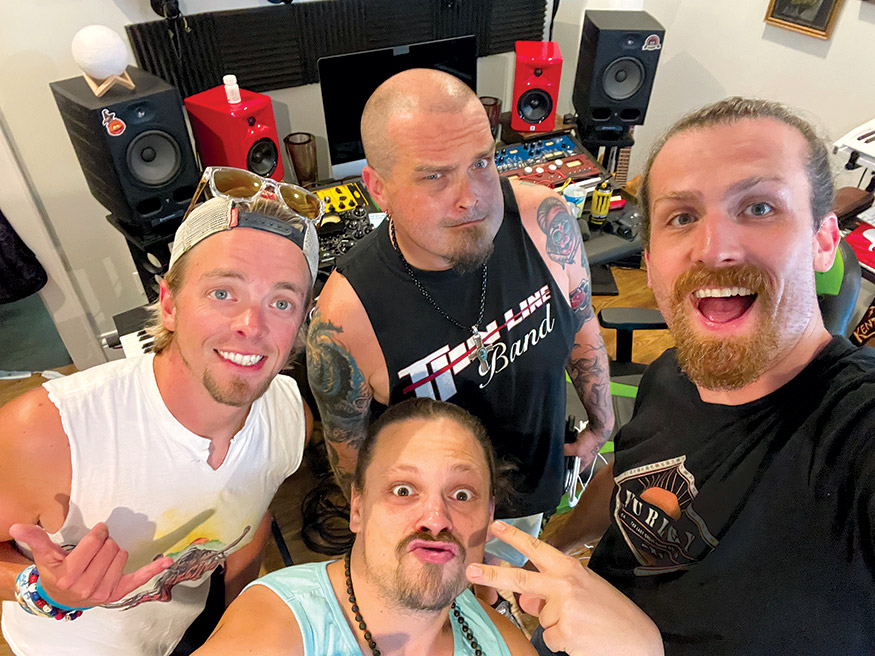
Left Ben Wells, top Chris Robertson, right John Fred Young, bottom Steve Jewell
Photo by Jordan Westfall


